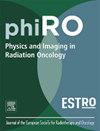基于锥束ct的放射治疗中前列腺运动和剂量畸变的估计
IF 3.3
Q2 ONCOLOGY
引用次数: 0
摘要
背景与目的:分节前列腺平移和旋转(6DoF)运动可引起剂量扭曲。由于分数内运动监测通常不可用,本研究比较了三种使用治疗前后锥形束ct (CBCT)来估计治疗期间前列腺定位误差及其剂量学影响的方法。材料与方法18例患者行前列腺放射治疗,术前设置CBCT。对于每个患者7-10个分数(总数:174),在光束照射期间每3秒获得触发的kv图像,并在治疗后获得CBCT。治疗期间的6DoF前列腺位置误差由kv图像(基础真值)确定,并根据cbct假设的静态位置(场景1)、cbct前后位置(场景2)之间的线性漂移或cbct后位置(场景3)中的静态位置来估计。将每种情况下的定位误差和前列腺剂量与地面真实值进行比较。结果scenario 1的前列腺位置均方根误差分别为1.1 mm(LR)、1.7 mm(AP)和1.8 mm(CC)。情景2和情景3同样准确,均方根误差分别为0.5 mm(LR)、0.9 mm(AP)和0.8 mm(CC)(情景2)和0.6 mm(LR)、1.1 mm(AP)和0.9 mm(CC)(情景3)。前列腺位置误差分别在24/ 15%的分数处使CTV D99.5%降低2/3 %以上。检测这些剂量亏缺的敏感性在场景1中较低(9 - 16%),而在场景2(68 - 76%)和场景3(86 - 91%)中相当高。所有情况均具有高特异性(93 - 99%)。结论使用治疗后立即获得的cbct后前列腺体位,在检测分段内前列腺体位错误和CTV剂量不足方面效果最好。它提供了一个可扩展的和保守的估计运动引起的剂量扭曲。本文章由计算机程序翻译,如有差异,请以英文原文为准。
Cone-beam CT-based estimations of prostate motion and dose distortion during radiotherapy
Background and purpose
Intra-fractional prostate translational and rotational (6DoF) motion can cause dose distortions. As intra-fractional motion monitoring is often unavailable, this study compares three methods to use pre- and post-treatment cone beam CTs (CBCT) to estimate prostate positioning errors during treatment and their dosimetric impact.
Material and Methods
Eighteen patients received prostate radiotherapy with pre-treatment CBCT setup. For 7–10 fractions per patient (total:174), triggered kV-images were acquired every 3 s during beam-on and a CBCT was acquired post-treatment. The 6DoF prostate position error during treatment was determined from the kV-images (ground truth) and estimated from the CBCTs assuming a static position as in the pre-CBCT(Scenario1), a linear drift between pre- and post-CBCT position(Scenario2) or a static position as in the post-CBCT(Scenario3). The positioning errors and prostate dose from each scenario were compared with the ground truth.
Results
Scenario1 was inferior to the others with prostate position root-mean-square errors of 1.1 mm(LR), 1.7 mm(AP) and 1.8 mm(CC). Scenario2 and 3 were similarly accurate with root-mean-square errors of 0.5 mm(LR), 0.9 mm(AP) and 0.8 mm(CC) (Scenario2) and 0.6 mm(LR), 1.1 mm(AP) and 0.9 mm(CC) (Scenario3). The prostate position errors reduced the CTV D99.5% by more than 2/3 % at 24/15 % of the fractions, respectively. The sensitivity in detecting these dose deficits was low for Scenario1 (9–16 %) and considerably higher for Scenario2 (68–76 %) and Scenario3 (86–91 %). All scenarios showed high specificity (93–99 %).
Conclusion
Using the post-CBCT prostate position, acquired right after treatment, performed best in detecting intra-fractional prostate position errors and CTV dose deficits. It offers a scalable and conservative estimate of motion-induced dose distortions.
求助全文
通过发布文献求助,成功后即可免费获取论文全文。
去求助
来源期刊

Physics and Imaging in Radiation Oncology
Physics and Astronomy-Radiation
CiteScore
5.30
自引率
18.90%
发文量
93
审稿时长
6 weeks
 求助内容:
求助内容: 应助结果提醒方式:
应助结果提醒方式:


